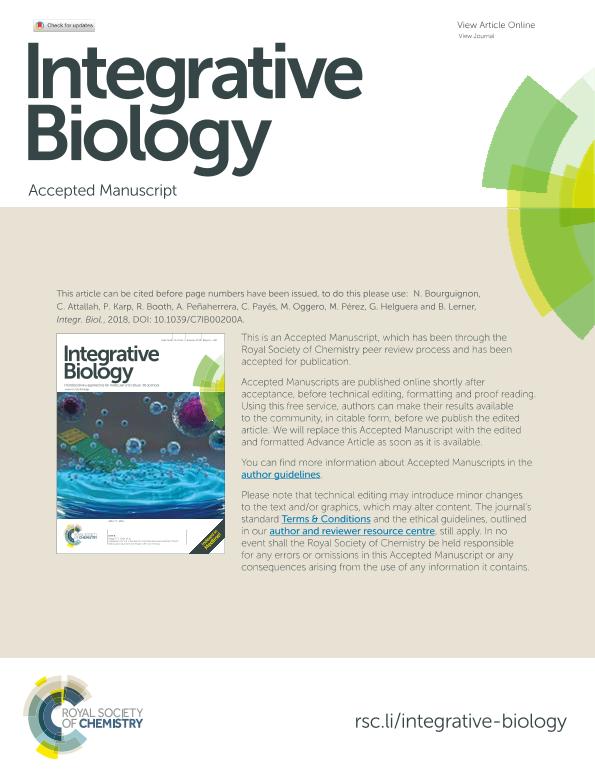Artículo
Production of monoclonal antibodies in microfluidic devices
Bourguignon, Natalia ; Attallah, Carolina Veronica
; Attallah, Carolina Veronica ; Karp, Paola Julieta
; Karp, Paola Julieta ; Booth, Ross; Peñaherrera Pazmiño, Ana Belén
; Booth, Ross; Peñaherrera Pazmiño, Ana Belén ; Payés, Cristian
; Payés, Cristian ; Oggero Eberhardt, Marcos Rafael
; Oggero Eberhardt, Marcos Rafael ; Perez, Maximiliano Sebastian
; Perez, Maximiliano Sebastian ; Helguera, Gustavo Fernando
; Helguera, Gustavo Fernando ; Lerner, Betiana
; Lerner, Betiana
 ; Attallah, Carolina Veronica
; Attallah, Carolina Veronica ; Karp, Paola Julieta
; Karp, Paola Julieta ; Booth, Ross; Peñaherrera Pazmiño, Ana Belén
; Booth, Ross; Peñaherrera Pazmiño, Ana Belén ; Payés, Cristian
; Payés, Cristian ; Oggero Eberhardt, Marcos Rafael
; Oggero Eberhardt, Marcos Rafael ; Perez, Maximiliano Sebastian
; Perez, Maximiliano Sebastian ; Helguera, Gustavo Fernando
; Helguera, Gustavo Fernando ; Lerner, Betiana
; Lerner, Betiana
Fecha de publicación:
03/2018
Editorial:
Royal Society of Chemistry
Revista:
Integrative Biology
ISSN:
1757-9694
Idioma:
Inglés
Tipo de recurso:
Artículo publicado
Clasificación temática:
Resumen
Herein, a microfluidic device with cistern design for cultivation of adherent eukaryotic cells for the production of recombinant proteins is presented. The geometric configuration of the microchannels in the device provided laminar flow with reduced velocity profiles in the cisterns, resulting in an adequate microenvironment for long-term adherent cell growth with passive pumping flow cycles of 24 hours. CHO-ahIFNα2b and HEK-ahIFNα2b adherent cell lines expressing a novel anti-hIFN-α2b recombinant monoclonal antibody (MAb) for the treatment of systemic lupus erythematosus were cultured on the surface of PDMS/glass microchannels coated with poly-d-lysine. A 24 day culture of CHO-ahIFNα2b cells resulted in MAb concentrations up to 166.4 μg mL -1 per day. The productivity of CHO-ahIFNα2b and HEK-ahIFNα2b cell lines was higher in the microdevice compared to that obtained using the adherent cell culture method (T-flask), with a 5.89- and 7.31-fold increase, respectively. Moreover, biological analysis of the MAbs produced in the microdevice showed no significant differences in the neutralizing antiproliferative activity of the hIFN-α2b or the cytokine cell signaling compared to the MAbs produced with cell adherent methods. These results suggest that this microfluidic device is suitable for long-term culture of mammalian cells and can improve the productivity of cells expressing recombinant MAbs with potential for therapeutic use without affecting the quality attributes of the product.
Palabras clave:
MICROFLUIDICS
,
MONOCLONAL
,
ANTIBODIES
Archivos asociados
Licencia
Identificadores
Colecciones
Articulos(CCT - SANTA FE)
Articulos de CTRO.CIENTIFICO TECNOL.CONICET - SANTA FE
Articulos de CTRO.CIENTIFICO TECNOL.CONICET - SANTA FE
Articulos(IBYME)
Articulos de INST.DE BIOLOGIA Y MEDICINA EXPERIMENTAL (I)
Articulos de INST.DE BIOLOGIA Y MEDICINA EXPERIMENTAL (I)
Articulos(SEDE CENTRAL)
Articulos de SEDE CENTRAL
Articulos de SEDE CENTRAL
Citación
Bourguignon, Natalia; Attallah, Carolina Veronica; Karp, Paola Julieta; Booth, Ross; Peñaherrera Pazmiño, Ana Belén; et al.; Production of monoclonal antibodies in microfluidic devices; Royal Society of Chemistry; Integrative Biology; 10; 3; 3-2018; 136-144
Compartir
Altmétricas



